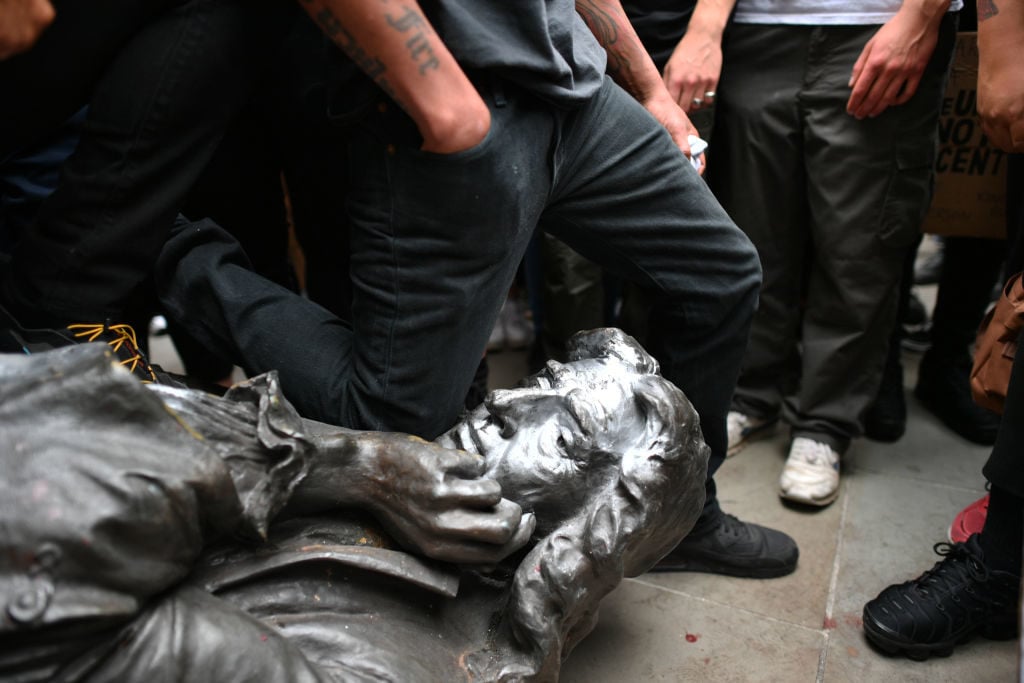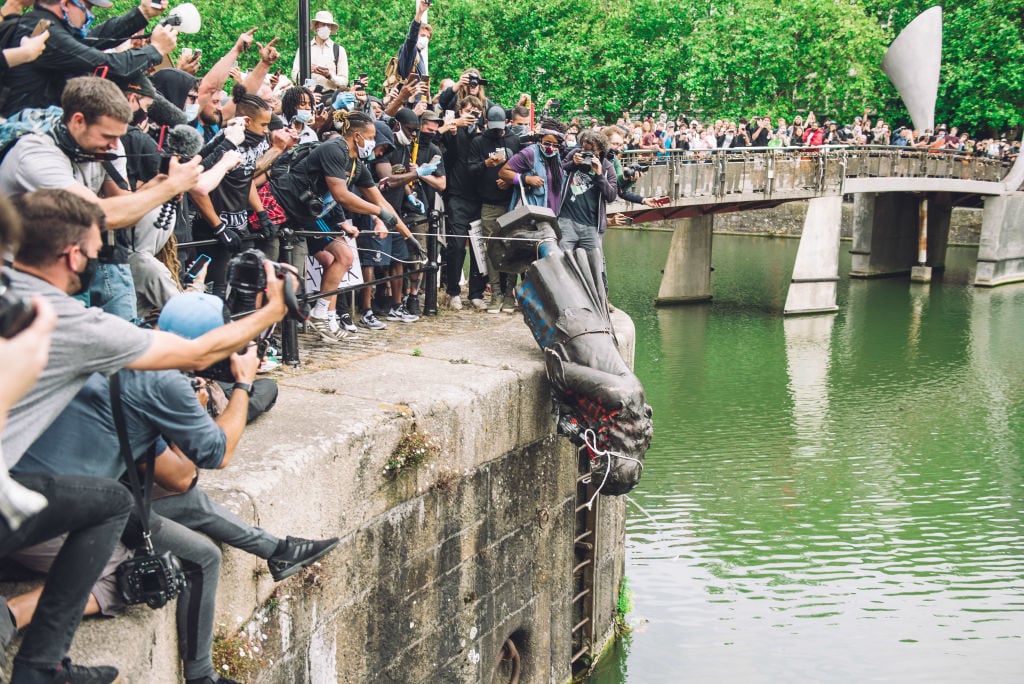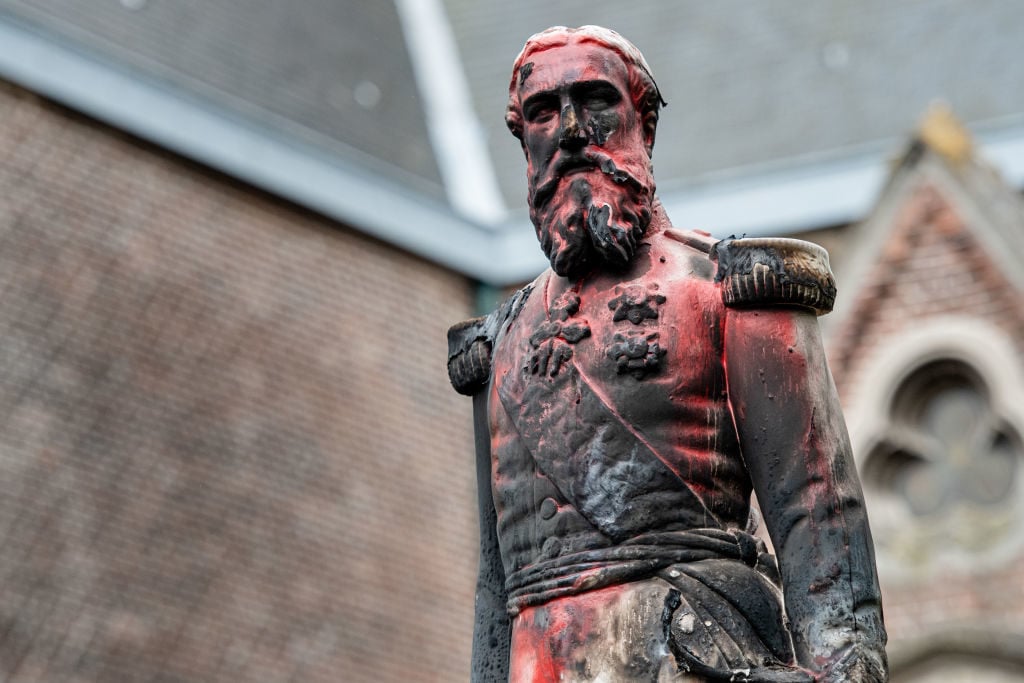Art World
Protesters Topple Colonialist Monuments in England and Belgium as Black Lives Matter Demonstrations Spread Across Europe
A statue of Edward Colston was tossed into Bristol harbor and monuments to King Leopold II were defaced in Belgium.

A statue of Edward Colston was tossed into Bristol harbor and monuments to King Leopold II were defaced in Belgium.

Naomi Rea

As Black Lives Matter demonstrations swell outside of the United States, protesters in Bristol toppled a statue commemorating a slave trader this past weekend and, in Belgium, defaced monuments to King Leopold II. In solidarity with the anti-racist marches following the brutal police killing of George Floyd, many Europeans are calling for a reckoning of their own countries’ racist histories.
Dramatic footage of the dunking of the slave trader monument into Bristol harbor on Sunday has circulated widely on social media. Before rolling the statue into the water, demonstrators pulled it down with ropes and knelt symbolically on its neck, recalling the way in which Floyd was killed.
The statue, which celebrates the philanthropy of the 17th-century slave trader Edward Colston had been in the city center since 1895, but was a point of contention for years. A plaque identified Colston as “one of the most virtuous and wise sons” of the city, but neglected to note that his wealth was built in part from the Royal African Company, whose ships transported some 84,000 slaves from Africa to the Americas between 1672 and 1689.
Over the years several “protest plaques” contextualizing Colston’s role in the slave trade were removed by Bristol City Council. In 2018, council said it would add its own second plaque to correct the record, but officials opposed the wording and the plans were eventually abandoned in 2019. In the wake of Floyd’s killing a petition demanding the removal of the bronze statue garnered more than 11,000 signatures.

Protesters transporting the statue of Colston toward the river Avon. Photo by Giulia Spadafora/NurPhoto via Getty Images.
Bristol’s mayor, Marvin Rees, who is himself of Caribbean descent and was the the first mayor of black African heritage elected in a major European city, tells the BBC that he does not feel any real sense of loss over the statue. “I can’t and won’t pretend the statue of a slave trader in a city I was born and grew up in wasn’t an affront to me and people like me,” Rees said, stressing however that he cannot condone criminal damage to public property.
“That statue is now under water, which is a piece of historical irony because undoubtedly people would’ve been thrown off the sides of the ships during that journey and there would be many African bodies on the bottom of the water,” the mayor said. He added that the statue will probably be recovered from the harbor “at some point” and that it was likely to end up in a city museum. Some are already calling for the statue to be replaced by one of civil rights campaigner Paul Stephenson.
Meanwhile, the local council has said that it collected signs from the protest for a display in the local M Shed museum, which highlights, among other things, the port city’s role in the slave trade.

The statue of Colston is pushed into the river Avon. Photo by Giulia Spadafora/NurPhoto via Getty Images.
Meanwhile in London, as thousands marched in mostly peaceful protests, some also targeted a monument to Winston Churchill, covering it in spray paint, asserting that Churchill “was a racist,” among other criticisms.
And, in Belgium, protesters set their sights on monuments to King Leopold II, who ruled over the country’s brutal colonial occupation of Congo during the 19th century. A petition calling for the removal of all likenesses of the racist king has more than 60,000 signatures.
In Brussels, outside of the Africa Museum, a bust of King Leopold II was covered in red paint. Other monuments in the cities of Antwerp, Ghent, and Ostend were also vandalized.

A statue of King Leopold II of Belgium is pictured on June 4, 2020 in Antwerp after being set on fire the night before. Photo by Jonas Roosens/Belga/AFP via Getty Images.
Debates surrounding colonial-era and Confederate monuments have gained new momentum during the Black Lives Matter protests, particularly after the governor of Virginia vowed to to remove a statue of Confederate general Robert E. Lee last week.
The conversation over problematic monuments has reached the Bahamas, too, where in Nassau people are calling for the removal of a statue of the explorer Christopher Columbus. Familiar debates have abounded, with critics bemoaning what they see as the erasure of history, and others, tired of the conversation, calling for immediate action.